Ostia Antica is an archaeological area located a few kilometres from Rome, part of the Archaeological Park of Ostia Antica. Walking through the ruins of Ostia Antica, you can envision the bustle of a cosmopolitan Roman city. It is a unique experience to see well-preserved streets, houses, baths, and warehouses and admire frescoes and mosaics.
Table of Contents
Ostia Antica: the ancient Rome’s river harbour
The archaeological area of Ostia Antica is part of the Ostia Antica Archaeological Park. It includes all the excavations of the cities of Ostia and Portus, located in the territory of the present-day towns of Ostia and Fiumicino. What we commonly call Ostia Antica was the first colony of Rome founded to have an outlet to the sea.
Today, the coastline has advanced so it is difficult to imagine how Ostia was close to the sea. The archaeological area is just at the ancient mouth of the Tiber. According to archaeological data, Ostia Antica, at the time called just Ostia, which means Gate, was founded in the 4th century BC as a military outpost (castrum). Then expanded and developed as an actual city surrounded by walls. Literature and mythology, however, hand down an even older foundation date.
The nearby Portus was instead a seaport, located in the present-day Fiumicino area, built later and connected to Ostia by a network of canals.
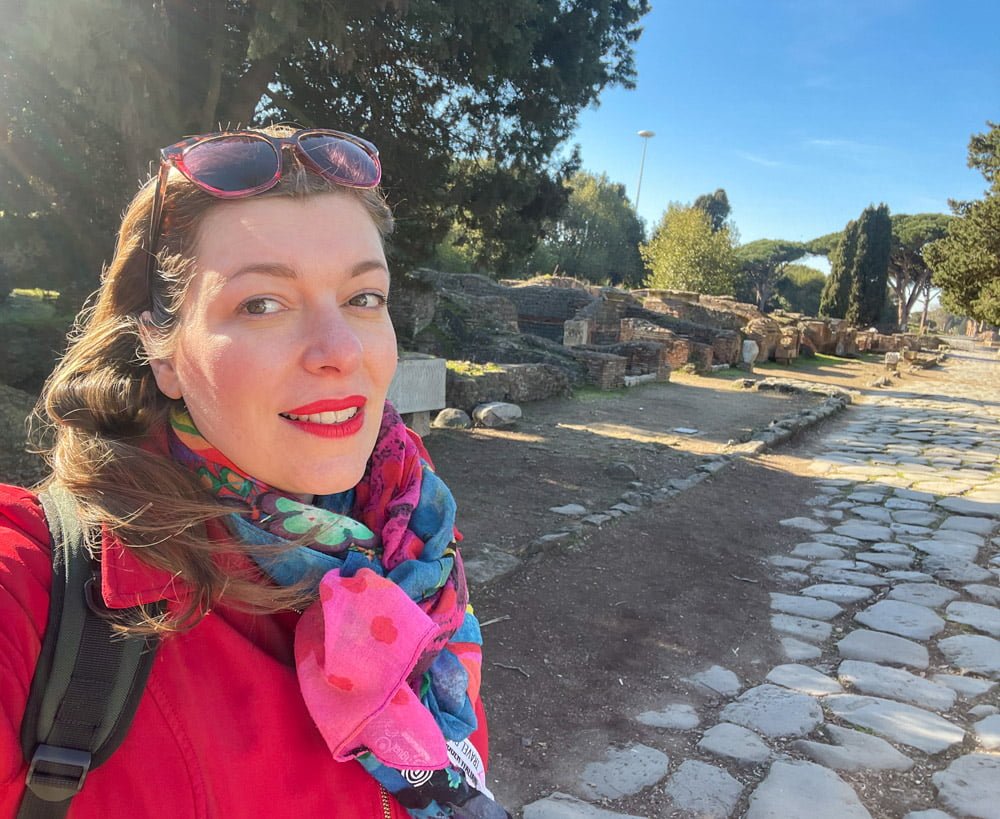
Ostia Antica: why it is not Lazio’s Pompeii
Many articles online point to the similarity between Pompeii and Ostia Antica, calling the latter ‘the Lazio’s Pompeii’. Still, Pompeii and Ostia Antica are two unique archaeological sites very different, although they both allow one to dive into the history of ancient Rome. The differences are geographical and related to how the two cities were abandoned. For these reasons there are significant consequences in how archaeologists approach the sites and the type of ancient ruins tourists can see.
Geographical differences between Ostia and Pompeii
Ostia Antica was a port located on the mouth of the Tiber. On the other hand, Pompeii was an inland city of Campania region. The structures and organisation of the two cities were, therefore, very different, as was the impact on the lives of the people there.
Being a port, Ostia Antica was a vital entry point for goods and people from different parts of the Roman world. It became a multicultural and cosmopolitan city with many public and private buildings, such as temples, baths, forums, theatres, housing and businesses.
On the other hand, Pompeii was a more isolated city. It relied mainly on agriculture and the trade of agricultural products such as fruit, vegetables, and olive oil. A series of streets and squares defined the city, with a central square and many private dwellings. Since it did not have a port, Pompeii was not a cosmopolitan city like Ostia Antica.
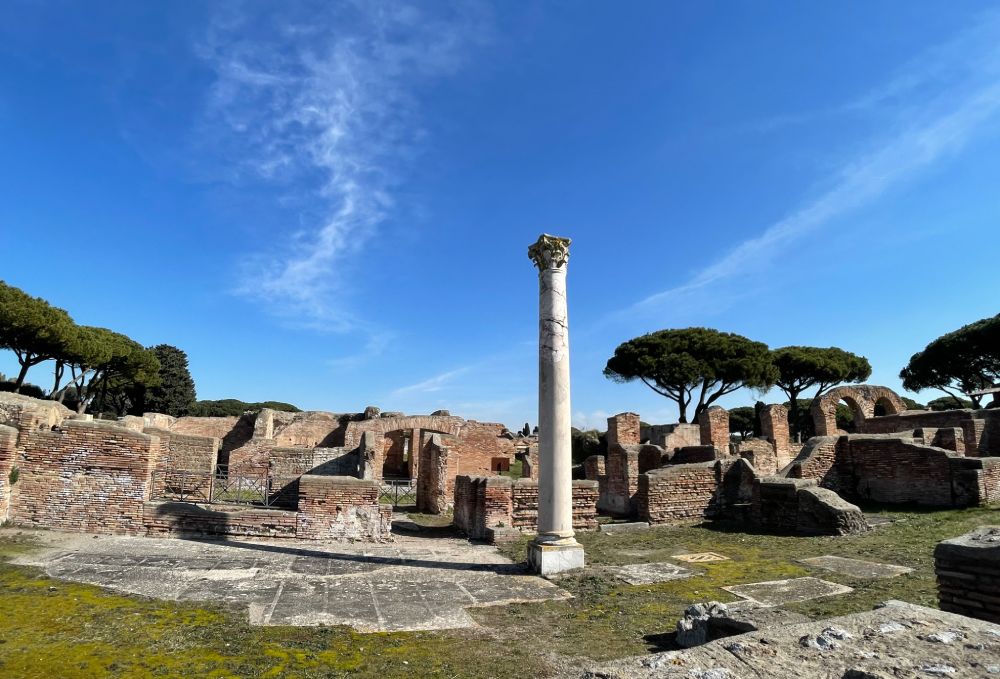
Archaeological differences between Ostia and Pompeii
The other significant difference, and the most important from an archaeological perspective, is how Pompeii and Ostia Antica were abandoned. As we know, Pompeii was catastrophically destroyed during the eruption of Vesuvius in AD 79, which buried the city under a blanket of ash and lapilli. This sudden event virtually sealed the city, preserving the houses and personal belongings of the people who lived in Pompeii. As a result, it offered archaeologists a snapshot of daily life in the city.
In contrast, the life of Ostia Antica and the neighbouring Portus continued well beyond AD 79. They were only gradually abandoned after the fall of the Western Roman Empire. The entire area in the Archaeological Park of Ostia Antica collapsed and suffered material thefts in later periods. River deposits and sand also partially buried it.
The long life of Ostia Antica tells archaeologists a long story more than a specific period such as Pompeii. Ostia Antica shows how an imperial city developed.
The painting in Ostia also documents a later taste than Pompeii, with essential subject differences. For example, there are very few erotic depictions in Ostia compared to Pompeii. This is a sign that they may have been covered in later periods before abandonment because of how tastes changed over time.
What’s on in Ostia Antica: must-see sights
Visiting this ancient Roman settlement a short distance from Rome is truly a unique experience. The paved entrance road, as are numerous buildings, is so well preserved. You can imagine the city when it was alive and populated. Among the most iconic sights in Ostia Antica are the Roman Theatre, the Forum of Ostia, the Baths of Neptune and the Necropolis. You can also admire beautifully preserved mosaics and frescoes from Roman times.
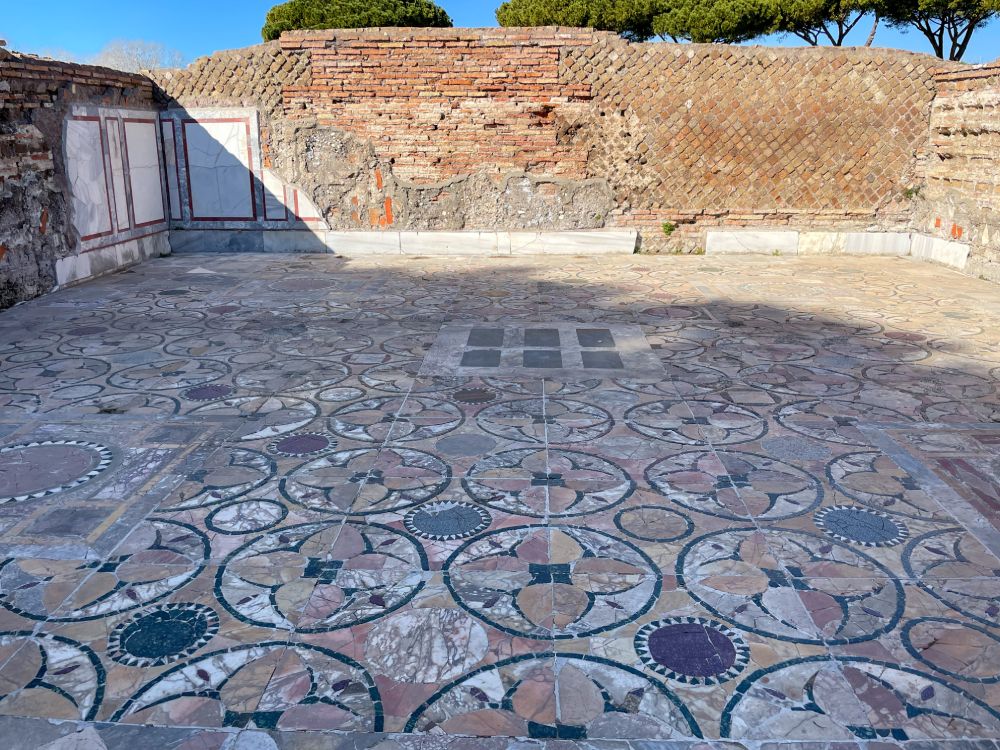
The Necropolis of Ostia
The first ruins you see when entering Ostia Antica from the Via Ostiense, the city’s main street, are the Necropolis’s buildings. The Necropolis is a monumental Roman cemetery, a burial ground with numerous tombs and funerary monuments.
The Necropolis of Ostia Antica is one of the largest in Lazio and dates back to the period between the 4th century BC and the 3rd century AD. The only rite performed in the Roman necropolises was the burial. The sites were deliberately located on the main street as a preview of the city’s importance to visitors.
The greater the importance of the Roman citizens buried there, the greater the city’s importance. Like in the Italian contemporary Catholic cemeteries, the Roman Necropolis housed different categories of tombs, depending on the social status and position of the deceased in society.
Some of the most elaborate tombs were for the noblest and most influential families. Others, more modest, were for ordinary citizens. For the formerly enslaved people who became Roman citizens, it was a great boast to be able to tell their story on their tomb.
Most visible tombs are brick enclosures with sarcophagi or space for cinerary urns, the two Roman burial methods. Basically, the tombs of the Ostia Antica Necropolis offer a unique window into Roman life. It shows how the society of the time conceived of death, the afterlife and eternity.
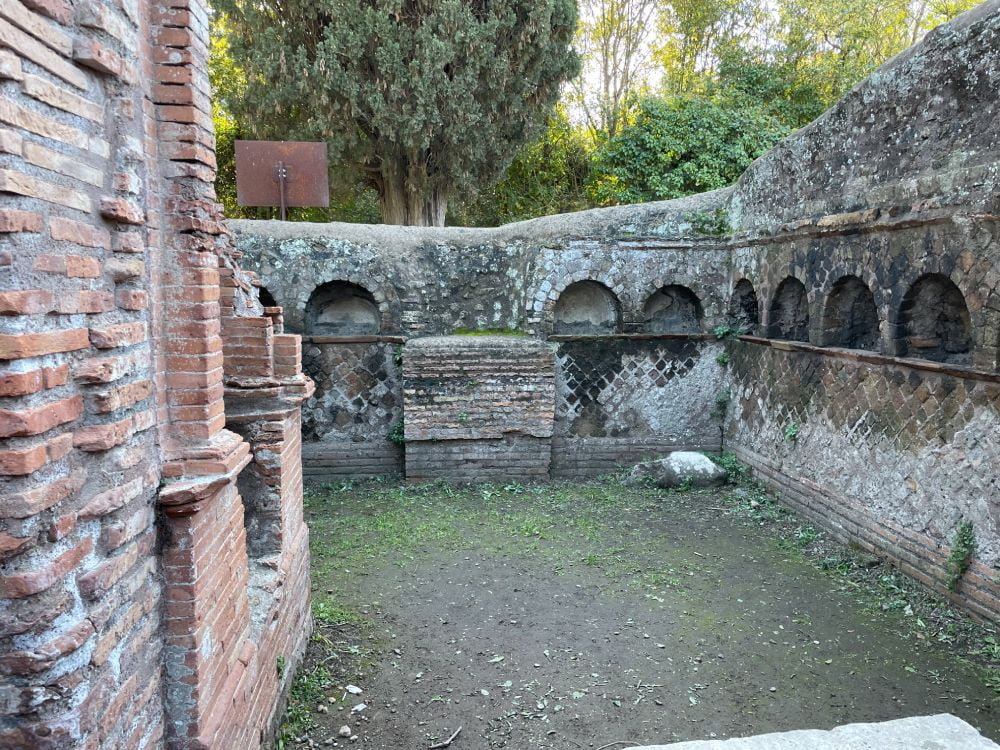
The Baths of Ostia Antica
The Roman baths were a custom that punctuated the day of all Romans of all social classes. The water in the Roman baths was not necessarily thermal water with curative properties. It could simply be hot water heated by a furnace, just as in many modern spas.
Roman baths were essential places for personal hygiene and care where Roman people could bathe and wash themselves. They was also places of recreation where to meet friends and engage in conversations. Because of Roman baths’ vital role in public hygiene, their cost was super affordable. You could have come in just for fee smaller than the access to a public toilet today.
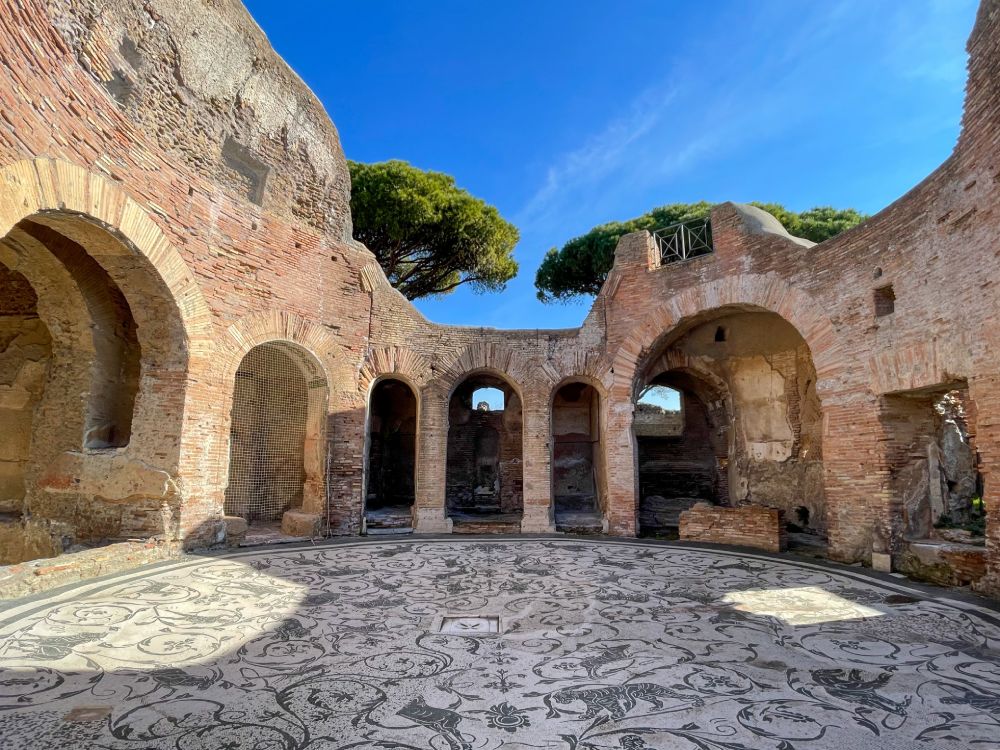
The Baths of the Cisiarii
After entering Ostia Antica through an imposing Roman gate, similar to a triumphal arch, the Via Ostiense changed its name, becoming the Decumanus Maximus. Since carts could not circulate within the city, the first building in Ostia Antica belonged to the guild of carters, called cisiarii in Latin.
In addition to having service areas, the corporation of the cisiarii offered their fellow carters the opportunity to refresh themselves at their bath after a long journey. Thanks to this habit of the ancient Romans, today we can see the beautiful mosaics of the Baths of the Cisiarii. There are a swimmer, dolphins, fantastic sea figures, chariots and statues. Although the mosaic looks incredibly sophisticated today, it was just a regular bath style in Roman times.
The Baths of Neptune
The Baths of Neptune, built in the 2nd century AD under Emperor Hadrian, are among the most important thermal complexes in Ostia. Their name derives from the large mosaic of Neptune, the god of the sea, inside the structure. The baths included several rooms with mosaic floors, including calidarium, frigidarium and tepidarium, a gymnasium and a gallery of statues of the imperial family.
The Roman Theatre of Ostia
The most spectacular building in Ostia Antica in every sense is the Roman Theatre, still used today as an open-air theatre during the summer season. Built in the first century AD, it was one of the main places of entertainment and spectacle in Ostia, with a capacity of about 4,000 spectators. Today, it only accommodates 2,000 because, over the centuries, it has lost part of the highest stands.
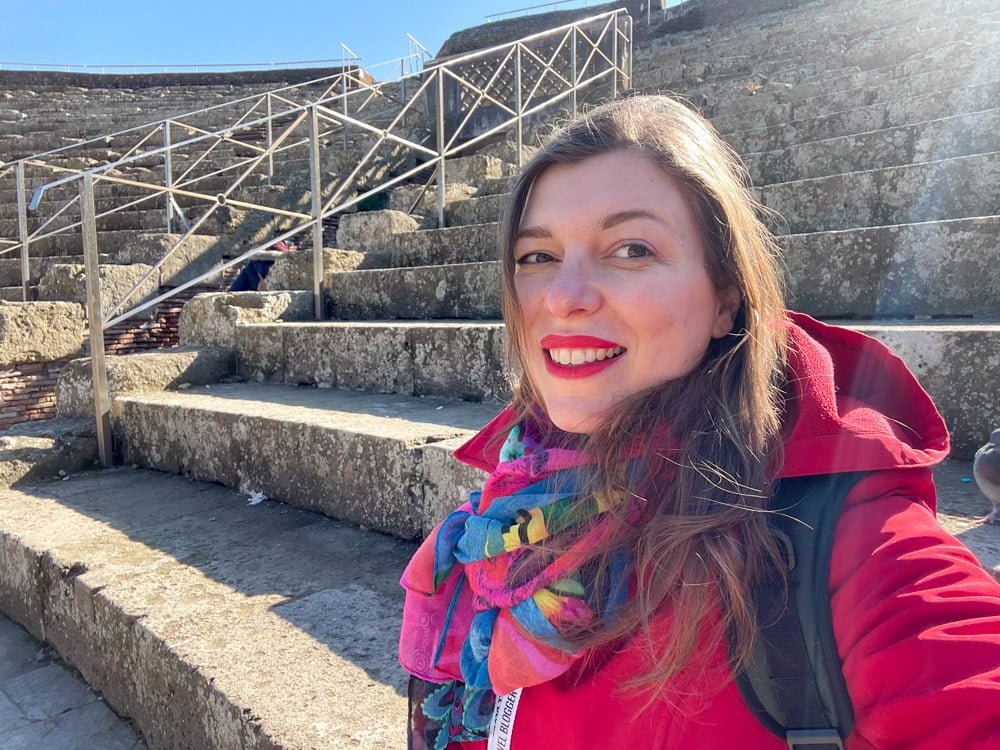
The theatre was split into three main parts: the tiers where spectators sat, the stage, and a backdrop decorated with columns. The most exciting aspect of the Roman Theatre of Ostia is that it was modified in the 5th century AD, transforming the stage into a pool for synchronised swimming shows.
In the Middle Ages, the Theatre of Ostia Antica was used for fortification since there was only countryside around it. After the abandonment of the Roman city, the buildings were slowly stripped to recycle the materials into new constructions.
However, nothing remained of the medieval alterations because the first restoration removed it all. In the past, during restorations, it was not usual to maintain the architectural additions showing the passage of time, like today. The restorers only wanted to show the grandeur of the Roman Empire.
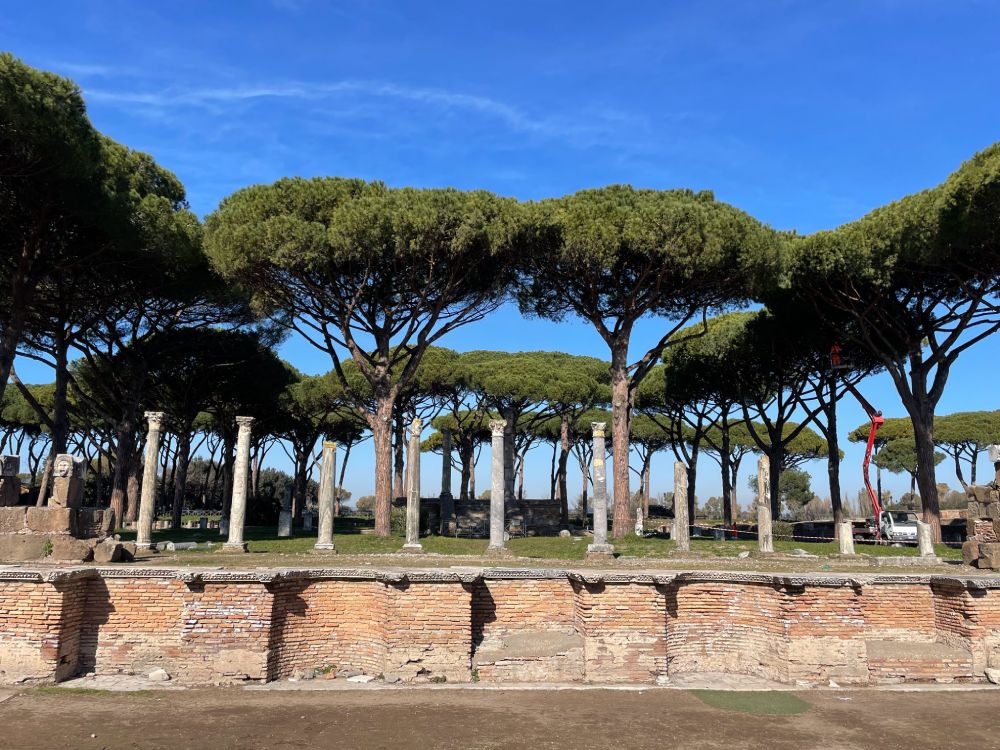
Houses and shops in Ostia Antica
The houses and shops in the archaeological area of Ostia Antica offer a unique insight into daily life in a Roman port city. Many domus have frescoes and statues depicting daily and mythological scenes.
The Domus of Cupid and Psyche owes its name to the splendid statue of the two lovers. Marble of different colours, designed with elegant geometric patterns, covered its floors and walls. On the contrary, the Caseggiato del Serapide was a luxury condominium with a garden and private baths.
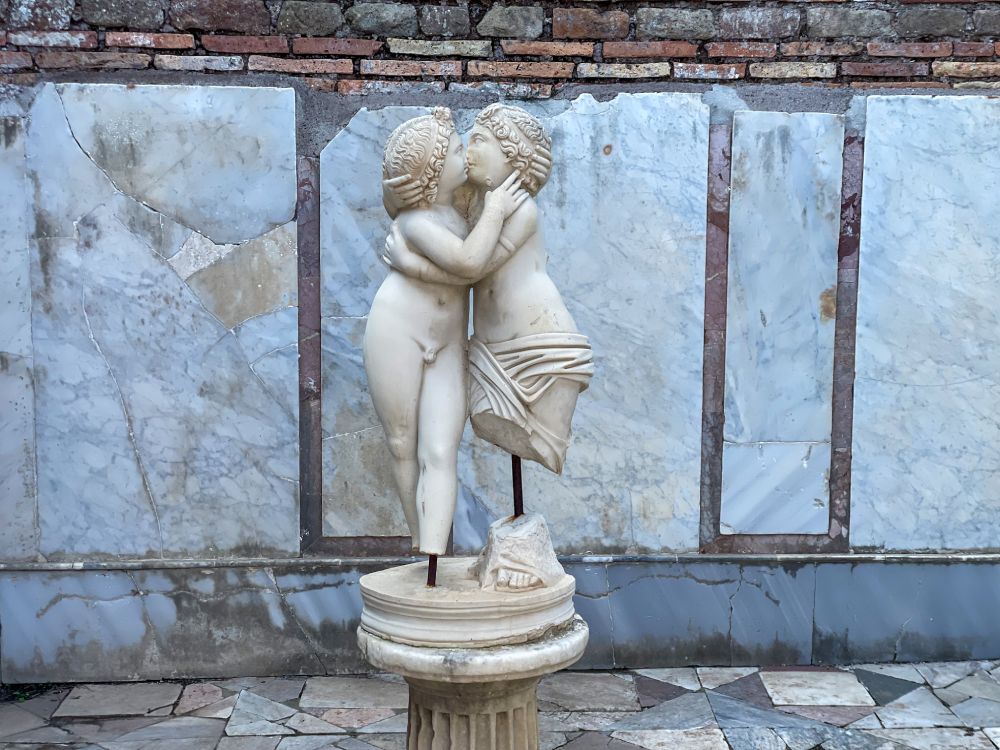
In addition to the more elegant Roman houses, you can also see small apartment blocks called insulae. They were multi-storey buildings built of brick, with sleek mosaic floors and walls painted with frescoes. The insulae occupied entire residential quarters, with the ground floor occupied by the owner’s flat and a shop facing the street. The entrances to the rented flats on the upper floors were at the back.
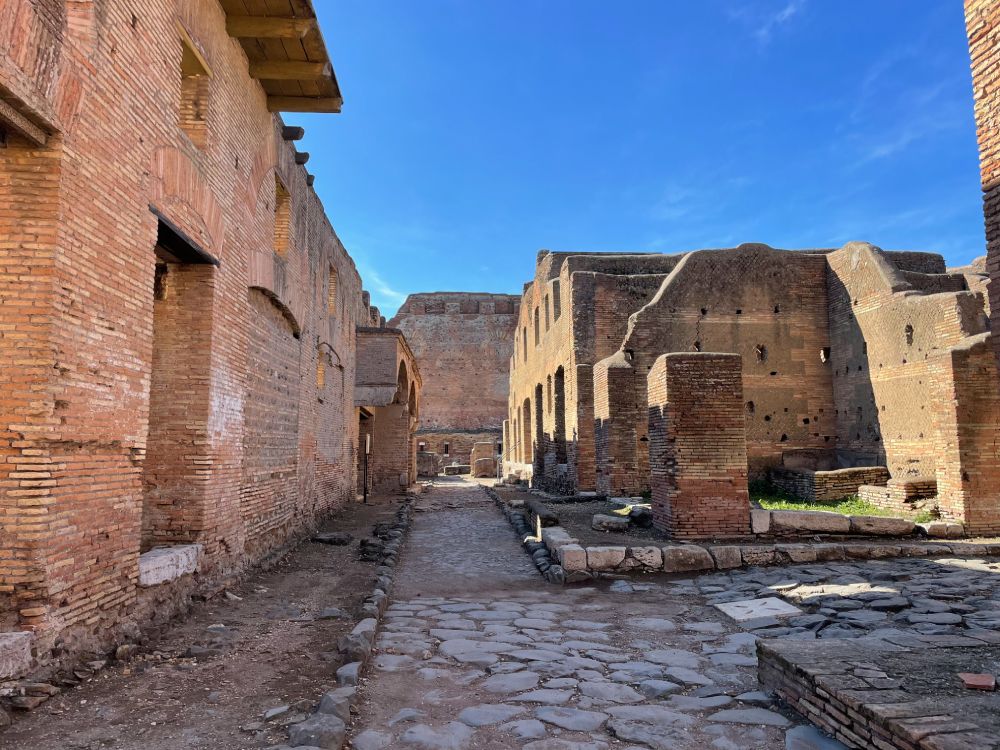
Neighbourhood shops
Shops in Ostia Antica sold about every product from the Roman Empire. There was also a large bakery that probably produced bread for Rome with ‘industrial’ ovens, a mill and grindstones made of lava stone, which required animals or enslaved people to function.
Mosaics and frescoes defined the type of trade in the shop. For instance, the fish shop’s floor was a mosaic with fish, including dolphins, marine mammals despised in Roman times. Since dolphins were considered competitors in fishing, the mosaic bore the inscription ‘inbide calco te’, or ‘enviously I tread on you’, almost as if to stomp the dolphins on the floor with a certain smugness!
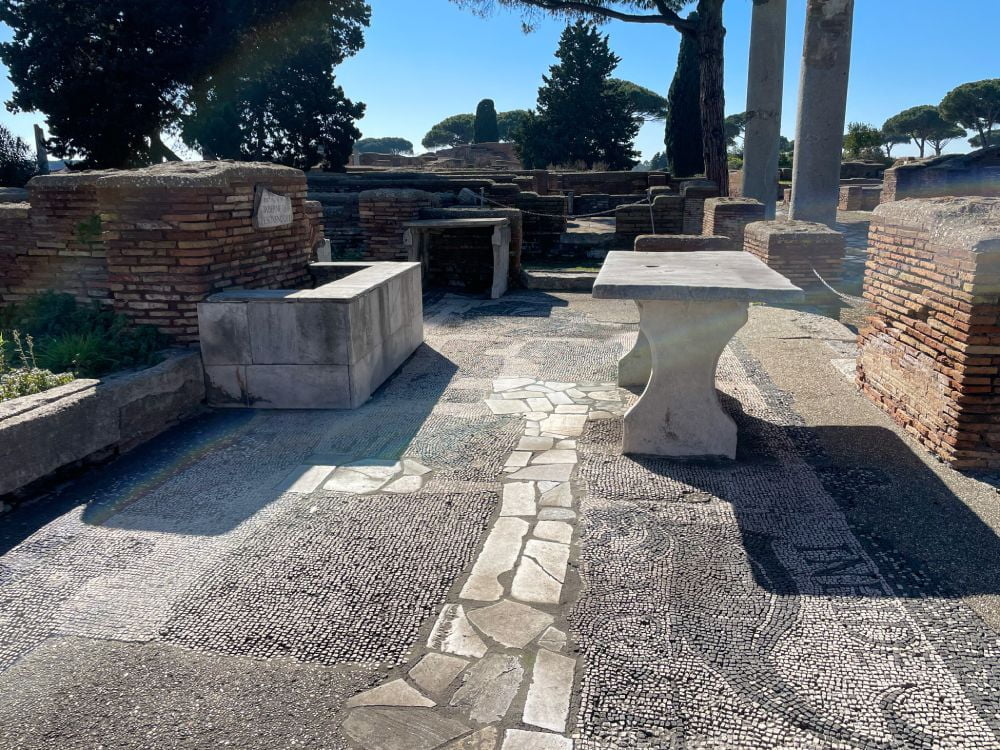
Roman diner
Not far away is the thermopolium, the traditional Roman diner to buy food and drink like a modern cafeteria. The thermopolium in Ostia served wine and had a ready-made menu frescoed on the wall. Interesting fact, the diner stored oil and beer in an underground reservoir, still recognisable, under the kitchen. The staff delivered food and drinks behind the still well-preserved marble counter, like in a contemporary fast food shop.
Small tiles predominantly cover the floor of the thermopolium, with only a partial mosaic because the age of this Roman diner is later than that of other buildings in Ostia Antica. The deco style was already different.
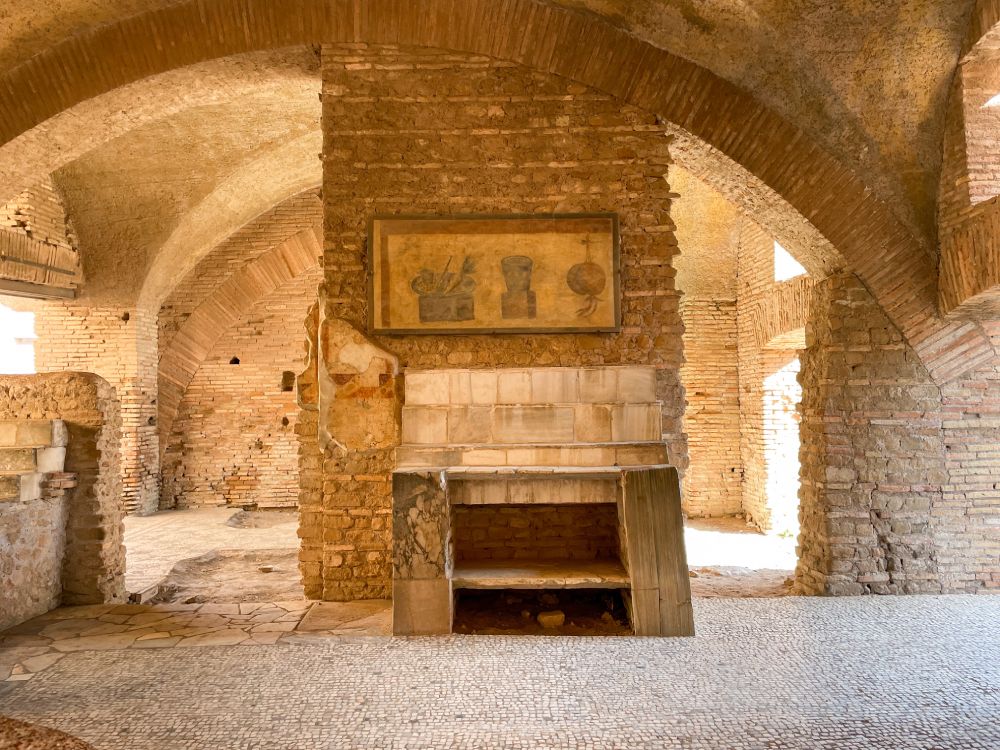
Commercial warehouses
Ostia Antica was also a port city that based its wealth on trade. Thus, there were not only local shops and diners but also numerous warehouses for storing the grain that arrived by ship. Trade companies had offices in the Square of the Corporations, a unique archaeological find. Under a portico were several rooms which housed the corporations’ offices. Archaeologists identified them by the mosaics depicting trades of navigation and commerce.
The Forum and places of worship in Ostia
The urban architecture of the Ostia city centre, with the main religious building in front of a large square, reminds one of the city centres of many Italian, French, or Spanish cities. Roman architectural influence has, in fact, survived over time.
The political and religious centre of Ostia Antica was the Forum, a large square where the population gathered for religious ceremonies and public debates, present in every Roman city. In the case of Ostia, the main religious building was the Capitolium, a temple dedicated to the Capitoline triad composed of the gods Jupiter, Minerva, and Juno, located on an altopodium, a raised structure with a flight of steps leading up to the temple.
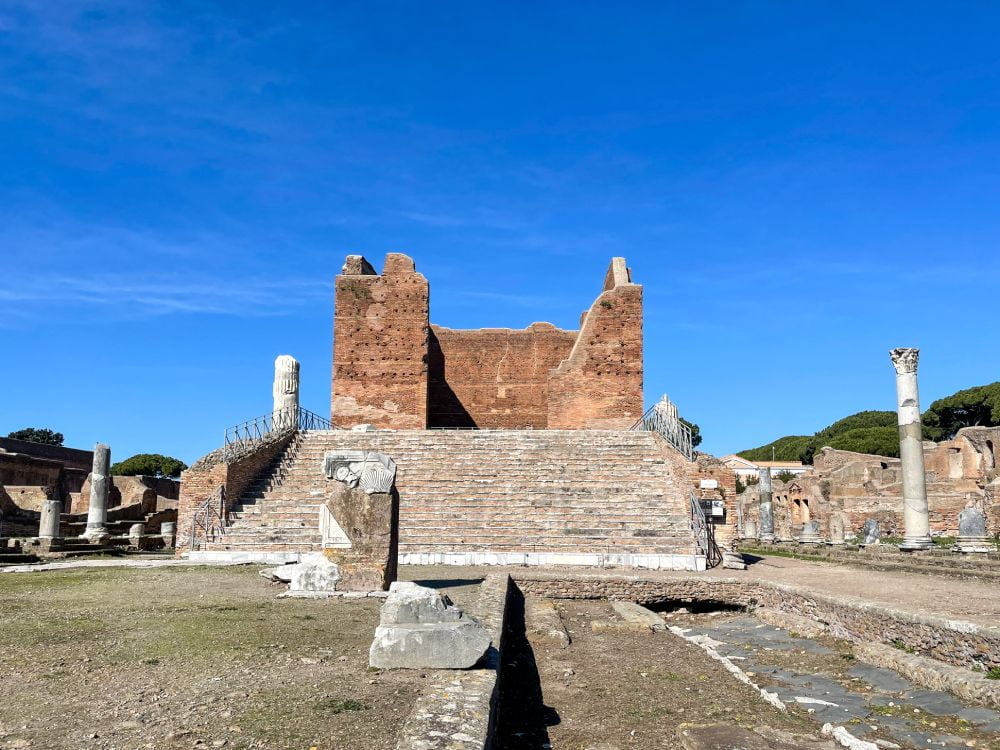
Opposite the Capitolium temple, completely covered in marble during Roman times, there was another temple dedicated to Augustus, later dismantled. These, however, were not the only temples in Ostia Antica. Outside the walls of the original castrum, around a new residential quarter, were three more temples.
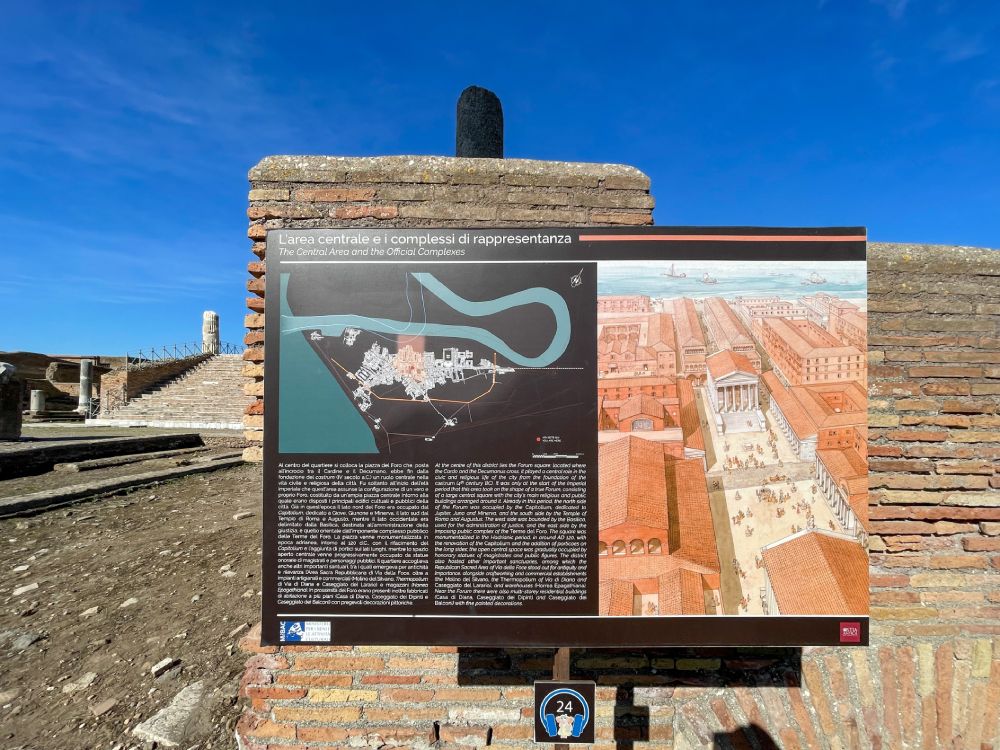
Oriental cults: Mithras and Isis
Besides the official gods, other religions were also practised in the Roman Empire. The so-called ‘Oriental cults’ were tolerated but viewed with suspicion by most of the population. One of these was the cult dedicated to the Egyptian goddess Isis, worshipped in Ostia and nearby Portus and in many other Roman settlements.
In Ostia Antica, you can also see about twenty mithraea, places of worship dedicated to the Persian god Mithras. Mithraism was a secret cult involving a path of initiation. The god Mithras, usually depicted in the act of sacrificing a bull, was worshipped in underground rooms.
I visited a Mithraeum in the basement of a bath, now known as the Baths of Mithras. The statue of the god was still in its original position, at the end of a dark corridor, with a beam of light from above illuminating its face.
In the early years after Christ, the cult of Mithras could almost be considered a competitor to Christianity. Both were cults practised in secret against the official religion. However, Christianity prevailed over Mithraism because it was a more democratic religion, also open to women, preaching equality among the faithful. In contrast, Mithraism remained an elitist religion, for the few males initiated into its mysteries.
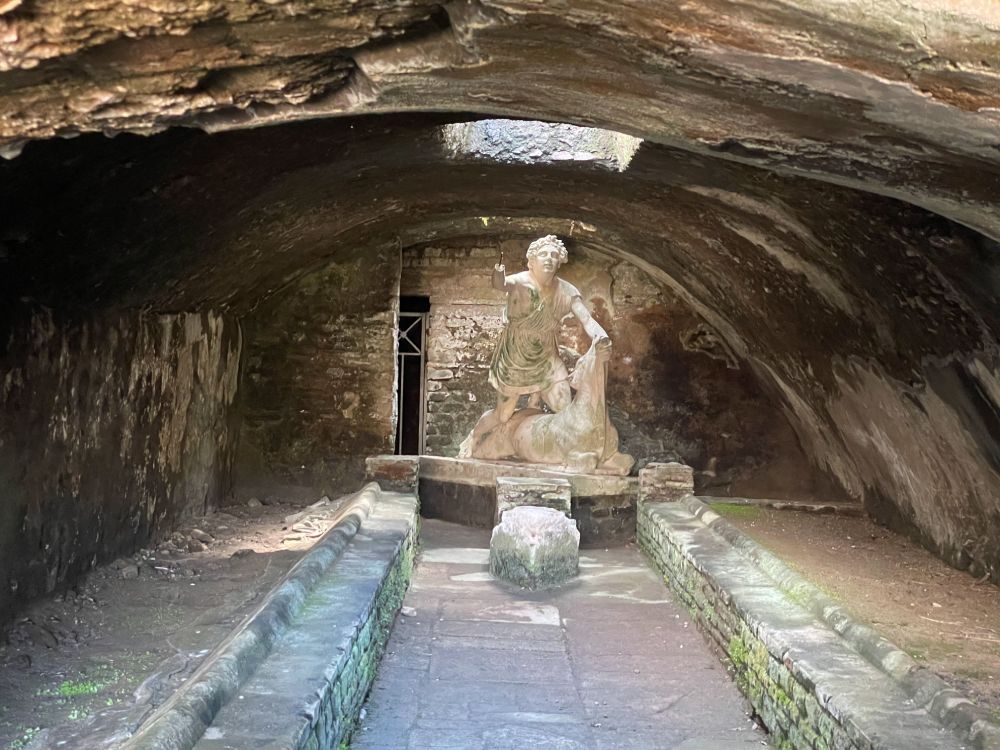
Practical information for visiting the Archaeological Park of Ostia Antica
To visit Ostia Antica, I advise you to wear comfortable shoes, suitable for walking on uneven ground, because they cover an extensive area. For the same reason, take a bottle of water with you.
The extent of the archaeological area of Ostia Antica is that of the Roman city of Ostia, a vast city with many streets and alleys to walk through. The Archeological Park of Ostia Antica includes more Roman sites in the surrounding area, a part of Ostia Antica itself.
When to visit Ostia Antica
The Ostia Antica archaeological area is open all year round, but the best seasons to visit are spring and summer, although it can be very hot in Lazio in summer. In winter and late autumn, the most beautiful mosaics are covered with plastic insulating fabric to protect them, and you may be unable to see them. However, always check the opening hours, as they vary depending on the season and the day of the week.
How much tickets to Ostia Antica cost
Tickets for Ostia Antica cost €18 at the ticket office and €24.50 online because booking fees are added (like almost everywhere else in Rome). They are valid for seven consecutive days and allow you to visit all the sites managed by the Archaeological Park, such as the Museum of the Roman Ships, the Necropolis of Porto at Isola Sacra, the Imperial Harbours of Claudius and Trajan, and the Julius II Castle.
You can buy tickets for Ostia Antica directly at the entrance. Still, I suggest you purchase tickets in advance, especially during the summer when the archaeological area is bustling.
Visit Ostia Antica with an archaeologist
The cheapest solution is to visit Ostia Antica on your own. There are signs with explanations in front of the most important ruins. However, this visit only lets you understand a little of Roman history, especially if you are not an expert.
The best way to visit the archaeological area of Ostia Antica is to join a tour with an archaeologist. Their guide is fundamental to discovering the curiosities and history of all the buildings since Ostia hosts buildings from different eras, thanks to the city’s long life.
No tour guides are on the site, so if you want to join a guided tour, you must book it in advance. At the ticket office, you can only pick up a map with the most famous sights of Ostia Antica and hire an audio guide, to be paid separately from the ticket price. An audio guide for the little ones is also available if you travel with children.
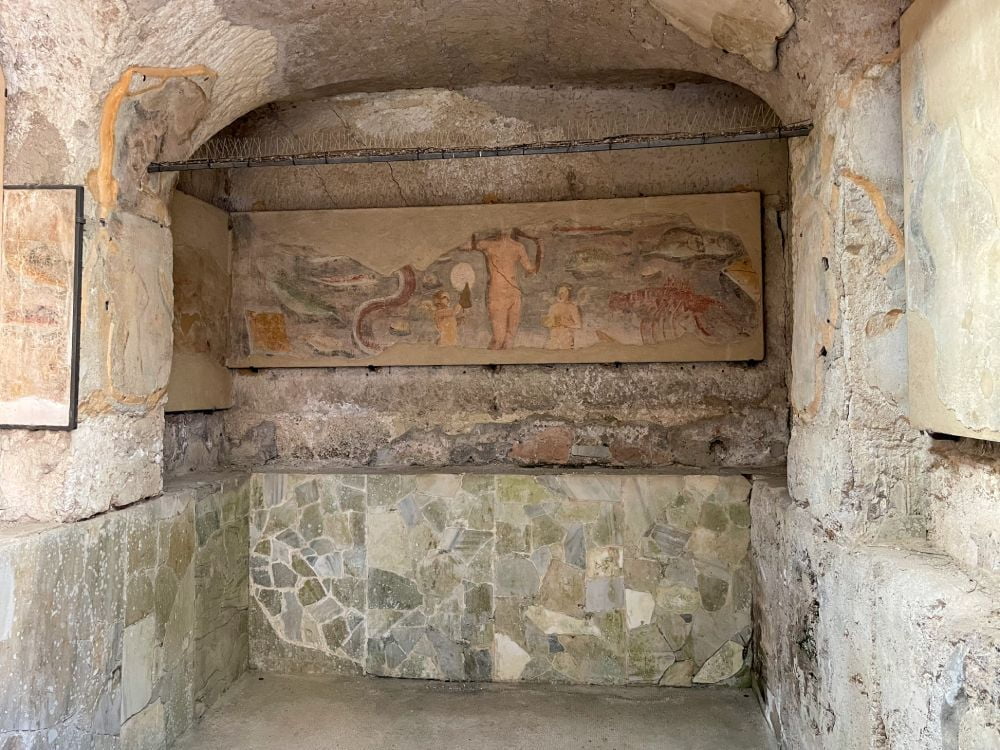
How to get to Ostia Antica
You can reach Ostia Antica by train or by car. By train, take the Roma-Lido di Ostia railway line and get off at Ostia Antica, a short distance from the entrance to the archaeological area. The train leaves from the Roma Porta San Paolo station, not the main stations Roma Termini or Roma Tiburtina. The first three train stations to Ostia Lido (Porta San Paolo, Basilica San Paolo, and EUR Magliana) are connected to the Rome Metro.
By car, you can park in the free car park in front of the archaeological area. Bear in mind that it is not very big, so it is better to arrive before the park opens in summer. However, with a car, you can also travel to the sites in Fiumicino, which are practically impossible to reach from Ostia Antica because they are poorly connected by public transport.
If you arrive in Rome by train or plane and want to see the other archaeological sites, check the car prices on Rentalcars because they usually have the best rates.
Area Archeologica Ostia Antica (Ostia Antica Archaeological Area)
Viale dei Romagnoli, 717
00119 Roma
Other sites in the Archaeological Park of Ostia Antica
The Archaeological Park of Ostia Antica includes the entire area of the ancient Roman harbours of Ostia and Portus, with several archaeological sites between Ostia and Fiumicino:
- the archaeological area of Ostia Antica in Ostia
- the Museum of Roman Ships at Fiumicino
- the Imperial Harbours of Claudius and Trajan at Fiumicino
- the Necropolis of Porto at Isola Sacra in Fiumicino
Although closely linked historically, the archaeological sites are not well connected by public transport. The most famous and visited is certainly the archaeological area of Ostia Antica because it is the best connected to Rome.
However, the sites of the Necropolis of Porto on Isola Sacra, the Imperial Harbours of Claudius and Trajan, and the Museum of Ships in Fiumicino are fundamental to understanding the development of maritime trade and relations with nearby Rome.
Ostia Antica is a fascinating and well-preserved archaeological site that offers a unique experience to immerse yourself in the life of ancient Rome. Feel free to comment if you have already visited this ancient Roman city or other sites of the Archaeological Park of Ostia Antica.
